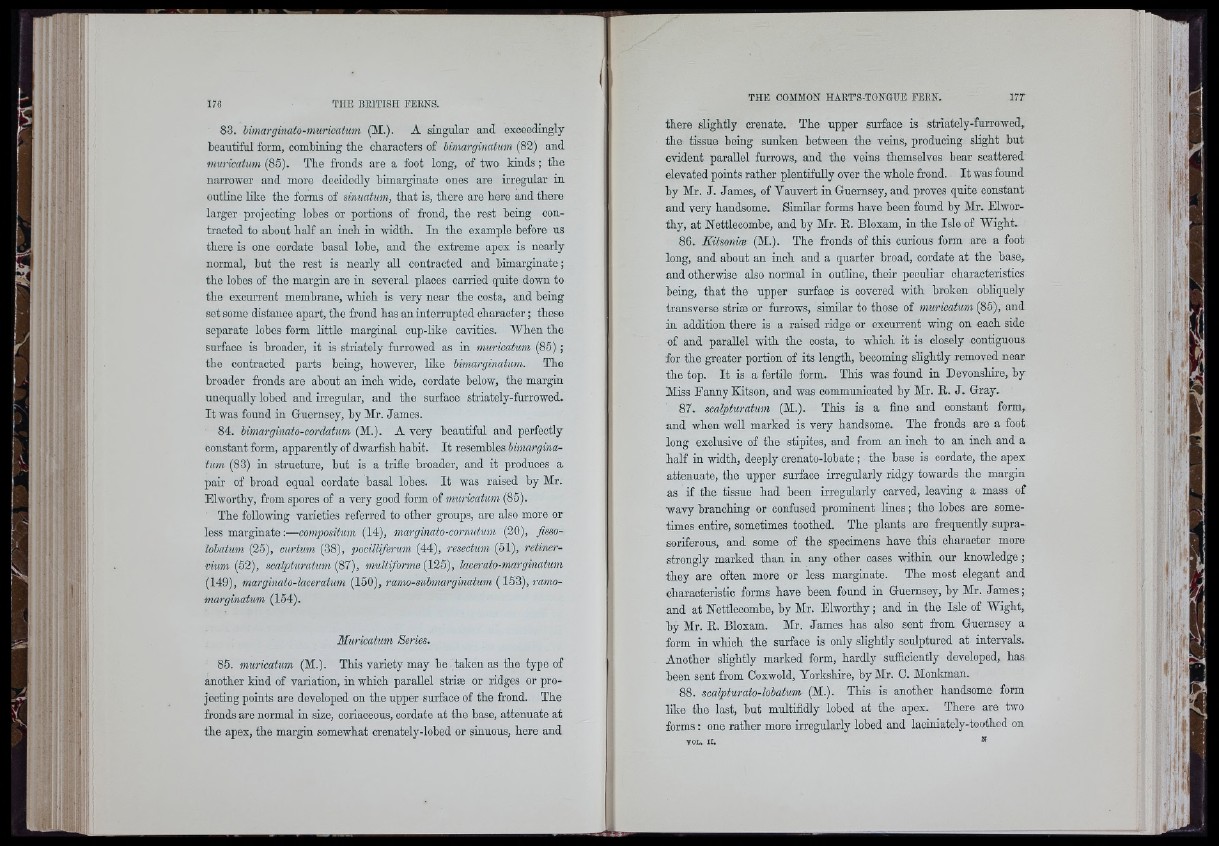
.
Ik
‘a f ,
a -iSii
83. bimarginato-muricatum (AI.). A singular and exceedingly
beautiful form, combining the characters of himarginatum (82) and
muricatum (85). The fronds aro a foot long, of two kinds ; the
narrower and more decidedly bimarginate ones are irregular in
outline like the forms of sinuatum, that is, there are here and there
larger projecting lobes or portions of fi-ond, tho rest being contracted
to about half an inch in width. In the example before us
there is one cordate basal lobe, and the extreme apex is nearly
normal, but the rest is nearly aU contracted and bimarginate;
the lohes of the margin are in several places carried quite down to
the exourrent membrane, which is very near the oosta, and hoing
set some distance apart, the frond has an interrupted character; these
separate lohes form little marginal cup-like cavities. AVhen the
surface is broader, it is striately furrowed as in muricatum (85) ;
the contracted parts being, however, Hke himarginatum. The
broader fronds are about an inch wide, cordate below, the margin
unequaUy lobed and irregular, and the surface striately-furrowed.
It was found in Guernsey, by Air. James.
84. bimarginato-cordatum (AI.). A very beautiful and perfectly
constant form, apparently of dwarfish habit. It resembles bimargina-
tiim (83) in structure, bnt is a trifle broader, and it produces a
pair of broad equal cordate basal lobes. It was raised by Air.
Elworthy, from spores of a very good form of muricatum (85).
The following varieties referred to other groups, are also more or
less marginate:—compositum (14), marginaio-cornutum (20), flsso-
lobatum (26), curium (38), pocilliferum (44), resectum (61), retiner-
rium (52), scalptiiratum (87), midtiforme (126), lacerato-marginatum
(149), marginato-laceratum (ISO), ramo-submarginatum (153), ramo-
marginatum (164).
Muricatum Series.
85. muricatum (AI.). This variety may be taken as the type of
another kind of variation, in which parallel striae or ridges or projecting
points are developed on the upper surface of the frond. The
fronds are normal in size, coriaceous, cordate at the base, attenuate at
the apex, the margin somewhat crenately-lobed or sinuous, here and
there sUghtly crenate. The upper surface is striately-furrowed,
the tissue being sunken between the veins, producing sUght but
evident paraUel furrows, and the veins themselves bear scattered
elevated points rather plentifully over the whole frond. It was found
by Air. J. James, of Vauvert in Guernsey, and proves quite constant
and very handsome. Similar forms have been found by Air. Elworthy,
at Nettlecombe, and by Air. R. Bloxam, in the Isle of Wight.
86. Kitsonice (AI.). The fronds of this curious form are a foot
long, and about an inch and a quarter broad, cordate at the base,
and otherwise also normal in outUne, their peouUar characteristics
being, that tho upper surface is covered with broken obliquely
transverse striie or furrows, similar to those of muricatum (86), and
in addition there is a raised ridge or excurrent wing on each side
of and paraUel with the costa, to which it is closely contiguous
for the greater portion of its length, becoming slightly removed near
the top. It is a fertile form. This was found in Devonshire, by
Aliss Fanny Kitson, and was communicated by Air. R. J. Gray.
87. scalpturatum (AI.). This is a fine and constant form,
and when weU marked is very handsome. The fronds are a foot
long exclusive of the stipites, and from an inch to an inch and a
half in width, deeply crenato-lobate; the base is cordate, the apex
attenuate, the upper surface irregularly ridgy towards the margin
as if the tissue had been irregularly carved, leaving a mass of
wavy branching or confused prominent lines; the lobes are sometimes
entire, sometimes toothed. The plants are frequently suprasoriferous,
and some of the specimens have this character more
strongly marked than in any other oases within our knowledge ;
they are often more or less marginate. The most elegant and
characteristic forms have been found in Guernsey, by Air. J ames;
and at Nettlecombe, by Air. Elworthy; and in the Isle of Wight,
by Air. R. Bloxam. Air. James has also sent from Guernsey a
form in which the surface is only slightly sculptured at intervals.
Another sUghtly marked form, hardly sufficiently developed, has
been sent from Coxwold, Yorkshire, by Air. 0. Alonkman.
88. scalpturato-lohatum (AI.). This is another handsome form
like the last, hut multifidly lobed at the apex. There are two
forms: one rather more irregularly lobed and laciniately-toothed on
fl|i|
! iriril
' l i k
•I ;
A